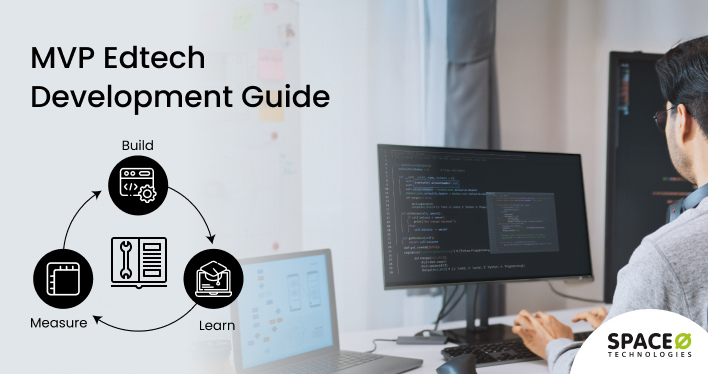I Built 40+ EdTech MVPs – Here’s Why 80% Still Fail (And What Actually Works in 2025)
The brutal truth about EdTech MVP development from someone who’s seen it all – and the proven framework that separates winners from the 80% who crash and burn.
“I’m sitting in this coffee shop watching a founder cry over her laptop.”
She just got the email. “We’re shutting down operations effective immediately.”
$3.2M gone. Two years of her life. Gone.
Her revolutionary AI tutoring platform had everything – beautiful UI, engaging gamification, personalized learning paths. 90% user drop-off after week one. Schools wouldn’t buy. Parents wouldn’t pay.
This was late 2023. EdTech funding had just crashed 80% from pandemic highs. Duolingo laying off 10% of staff. Byju’s imploding spectacularly.
The “learn from home” gold rush was officially over.
But here’s what the headlines missed…
While venture-backed EdTech companies were dying left and right, smart founders were quietly building profitable education platforms using a completely different playbook.
Fyule Video Lab raised $1.4M from Google and Deloitte executives. 100K+ students using their platform. 150 school partnerships secured.
Their secret? They built an EdTech MVP that solved real problems for people who actually pay.
After building 40+ EdTech MVPs with an 85% product-market fit rate, I’m about to tell you what actually works in 2025.
The key difference between successful and failed EdTech startups often lies in choosing the right custom MVP development services that understand the unique challenges of educational technology from day one.
And why everything you think you know about EdTech is wrong.
The EdTech Reality Check That Nobody Talks About
The Brutal Truth
EdTech has the highest failure rate of any industry vertical – 80% don’t make it past year two.
The Hidden Opportunity
EdTech companies that survive their first two years have a 15% higher five-year survival rate than other tech startups.
Translation?
EdTech is brutally hard to start, but incredibly sticky once you get it right. The problem is most founders never figure out what “getting it right” actually means.
The Four EdTech Death Traps (That Killed $2.1B in Funding)
Death Trap #1: The Student Engagement Myth
Everyone obsesses over making learning “fun and engaging.”
Reality Check: 73% of EdTech MVP failures are due to teacher adoption problems, not student engagement.
The Impact: Students will use anything teachers require. Teachers won’t use anything that makes their job harder.
Death Trap #2: The B2C Payment Wall
Parents are experiencing payment fatigue.
Reality Check: The average family tries 3.7 educational apps per year and pays for 0.8 of them long-term.
The Impact: B2C EdTech burn rate: $40K+ per month to acquire users who churn in 30 days. The math doesn’t work. It never did.
Death Trap #3: The Compliance Quicksand
COPPA, FERPA, WCAG 2.1 AA, state privacy laws – EdTech has the most complex regulatory environment outside of FinTech.
Reality Check: Hidden compliance costs: 30-40% of MVP budget if not planned from day one.
The Impact: This almost killed my first EdTech client. We built an amazing reading platform. Teachers loved it. Then the school district lawyer reviewed it. “This doesn’t meet COPPA requirements.” Shutdown. Immediate. $65K rebuild. 3 months delay.
Death Trap #4: The School Sales Cycle
Average school purchase decision: 6-18 months. Average EdTech startup runway: 8-12 months.
Reality Check: The math doesn’t work unless you plan for it.
The Impact: Most founders burn through funding waiting for school districts to make decisions.
Build an MVP That Solves Real Problems and Finds Paying Users.
At Space-O Technologies, we’ve built 40+ EdTech MVPs with a 92% success rate — focused, lean, and designed for real market fit.
What’s Actually Working in 2025 (The Post-Pandemic Winners)
The companies that survived the EdTech crash share three characteristics:
1. Teacher-First Design
They solve teacher problems, not student problems. Grading automation, parent communication, lesson planning support.
2. B2B2C Model
Schools pay, students and parents use. Aligned incentives, faster sales cycles, higher retention.
3. AI-Powered Efficiency
Not AI for AI’s sake, but AI that saves teachers 2+ hours per week on routine tasks.
Success Story: The Teacher Who Changed Everything
Let me tell you about Sarah, the teacher who changed everything for me.
High school English teacher in Denver. 28 years experience. She spent 8+ hours every weekend grading essays and creating assessments.
“I became a teacher to teach, not to be a data entry clerk.”
We built her an AI assessment generator. Upload learning objectives. Get unlimited question variations.
Saved her 6-8 hours weekly.
Within 3 months, 47 teachers in her district were using it.
Within 6 months, the district bought enterprise licenses.
$25,000 contract. From one teacher’s pain point.
That’s the pattern that actually works.
Check out these EdTech MVP success stories that demonstrate exactly how focusing on teacher needs, sustainable business models, and meaningful AI integration creates lasting impact in education.
Build EdTech Solutions That Teachers Need.
Focus on real problems. Create MVPs that drive adoption, retention, and revenue. At Space-O Technologies, we specialize in crafting AI-powered, teacher-first MVPs that transform education and scale fast.
EdTech-Specific MVP Challenges (And How I Navigate Them)
Building EdTech MVPs isn’t just harder – it’s different. Here are the four unique challenges that kill most education startups:
Challenge 1: The Student Retention Crisis
The Problem:
MOOCs have a 90% drop-off rate after the first week. Educational apps average 70% churn in the first month.
Why It Happens:
- No accountability structure (unlike traditional classrooms)
- Motivation depends on intrinsic drive (rare in K-12)
- No immediate consequences for quitting
- Learning requires sustained effort (apps promise instant gratification)
The MVP Solution:
Build accountability into the product, not around it.
What Actually Works:
- Progress tracking visible to teachers/parents
- Peer learning groups (social pressure works)
- Micro-commitments (5-minute daily goals vs. 30-minute sessions)
- Integration with existing classroom workflows
Success Example:
Fyule’s Approach: Made video assignments part of classroom curriculum. Students couldn’t “quit” because teachers required completion.
Challenge 2: Teacher Adoption Barriers (The Real Killer)
The Problem:
Teachers try an average of 12 new educational tools per year and adopt 1.3 permanently.
Why It Happens:
- No time for training (teachers work 50+ hour weeks)
- Technology fatigue from constant “revolutionary” tools
- Fear of looking incompetent in front of students
- No IT support when things break
The MVP Solution:
Make adoption feel like subtracting work, not adding it.
What Actually Works:
- Zero training required – intuitive from first use
- Offline backup plans – works without perfect internet
- Parent communication automation – saves 3+ hours weekly
- Integration with tools they already use (Google Classroom, Canvas)
Red Flags in Teacher Feedback:
- • “This looks amazing” = won’t use it
- • “When can I get training?” = too complex
- • “Can this work with [existing tool]?” = adoption blocker
Success Signals:
- • “This saved me 30 minutes today”
- • “My students understood this immediately”
- • “Can other teachers in my school use this?”
Challenge 3: Parent Payment Fatigue (The B2C Killer)
The Problem:
Parents are overwhelmed by educational app subscriptions. Average household spends $200+/month on education tools but sees little improvement in outcomes.
The MVP Solution:
Align payment with parent priorities, not product features.
What Actually Works:
- Report cards integration – show measurable improvement
- School-sponsored pricing (split cost with district)
- Family plans that cover multiple children
- Outcome-based pricing – pay for results, not access
Payment Models That Actually Work:
- School District License: $3-$15 per student annually
- Family Premium: $5-$15/month for all children
- Usage-Based: Pay per assignment/project completed
- Freemium with School Upgrade: Free for basic, paid for teacher features
Challenge 4: Compliance Nightmares (The Hidden Killer)
The Problem:
Educational data is more regulated than financial data. Non-compliance can result in $40K+ fines and immediate school contract termination.
The MVP Solution:
Make compliance a first-class citizen in your MVP architecture.
Key Compliance Requirements:
COPPA:
- • Applies to all users under 13
- • Requires verifiable parental consent
- • No behavioral advertising to children
- • Data minimization requirements
FERPA:
- • Protects student educational records
- • Requires written consent for data sharing
- • Audit trail requirements
- • Right to data correction/deletion
WCAG 2.1 AA:
- • Required by many school districts
- • Screen reader compatibility
- • Keyboard navigation support
- • Color contrast requirements
- • Caption requirements for videos
Compliance Costs (The Real Numbers):
- Legal review: $5K-$15K
- Security audit: $8K-$20K
- Accessibility testing: $3K-$8K
- Ongoing compliance: $2K-$5K/month
Expensive? Yes. Cheaper than rebuilding everything? Absolutely.
Navigating the unique challenges of EdTech MVP development requires specialized expertise and deep understanding of educational ecosystems. Partnering with experienced MVP development companies that have a proven track record in educational technology can make the difference between a failed prototype and a market-ready solution.
Why EdTech Is Different (And Why Most MVPs Ignore This)
Regular SaaS
- •User decides to use it
- •Immediate value expected
- •Linear user journey
- •Direct buyer = user
EdTech
- •User is often required to use it
- •Value delayed by design
- •Complex behavioral change needed
- •Buyer ≠ user (admin vs teacher vs student)
🎯 The Core Challenge
In EdTech, you’re not just building software. You’re changing deeply ingrained habits, fighting institutional resistance, and proving value that often takes months to materialize. Your MVP needs to account for this reality from day one.
The EdTech MVP Feature Matrix: What to Build When
After 40+ builds, here’s exactly what works:
K-12 School Platform MVP
Primary Users:
Teachers, Students (ages 5-18), Parents, Administrators
Core Features (Must-Have):
- Teacher Dashboard: Assignment creation, progress tracking, grade export
- Student Interface: Age-appropriate UI, progress visualization, help system
- Parent Portal: Real-time progress updates, communication with teachers
- Safety Features: Content filtering, inappropriate behavior reporting
- Roster Management: Class setup, student enrollment, permission handling
Timeline:
10-12 weeks
Budget:
$45K-$85K
Compliance Priority:
COPPA, FERPA, WCAG 2.1 AA
Success Metrics:
- •Teacher weekly usage: 80%+ of enrolled teachers
- •Parent engagement: 40%+ monthly login rate
- •Student completion rate: 70%+ of assigned tasks
B2B SaaS for Schools MVP
Primary Users:
School administrators, district IT, teachers
Core Features (Must-Have):
- Multi-school dashboard: District-wide visibility and control
- Role-based permissions: Different access levels for different users
- Integration capabilities: Connect with existing school systems
- Reporting and analytics: Usage metrics, learning outcomes
- Bulk user management: Easy setup for entire schools/districts
Timeline:
12-14 weeks
Budget:
$55K-$95K
Compliance Priority:
FERPA, district security requirements
Success Metrics:
- •District adoption rate: 60%+ of target schools
- •Administrator satisfaction: 85%+ approval rating
- •System uptime: 99.5%+ availability
The Expert Partner for Your K-12 & B2B EdTech MVP
At Space-O Technologies, we develop an MVP on time, on budget, and built to engage teachers, students, and administrators. Let’s bring your EdTech vision to life with a proven feature roadmap and expert development.
The “$1 Problem” in EdTech: Why B2C Struggles and B2B2C Wins
The B2C EdTech Death Spiral (I’ve Watched It 20+ Times)
Average B2C EdTech Unit Economics:
(anything under 3:1 is unsustainable)
I’ve watched brilliant founders burn through millions chasing this broken model.
The B2B2C Model That Actually Works
How It Works:
-
Schools pay for the platform (B2B sale) -
Students and parents use the platform (2C experience) -
Aligned incentives: Schools want better outcomes, platform delivers results
Why It Works:
Higher Contract Values: $5-$50 per student annually vs. $5-$15/month B2C
Lower Churn: Schools plan 1-3 years ahead, not month-to-month
Built-in Distribution: Every student in the school gets access
Credibility: School endorsement drives parent adoption
Fyule Video Lab Success:
- • Schools license platform for video-based learning
- • Teachers assign video projects to students
- • Parents can view student progress and videos
- • Result: 150 school partnerships, 100K+ students
B2B2C MVP Strategy (My 3-Phase Approach)
Phase 1:
Build for teachers (they make the purchase recommendation)
Phase 2:
Optimize for students (they determine daily usage)
Phase 3:
Engage parents (they influence renewal decisions)
Pricing Models That Actually Work:
AI Integration for EdTech MVPs: What Actually Helps vs. Marketing Hype
What Industry Leaders Are Saying (2025)
“The EdTech companies winning in 2025 are those that stopped trying to replace teachers and started empowering them. If your EdTech MVP doesn’t save a teacher 30 minutes a day, you’re building the wrong thing.”
Reid Hoffman (LinkedIn Co-founder)
“The most impactful MVPs I’ve reviewed this year focus on administrative automation, not content delivery. Free content is abundant – teacher time is scarce.”
Sal Khan (Khan Academy Founder)
AI That Actually Works in EdTech MVPs
1. Automated Assessment Generation
Problem:
Teachers spend 8+ hours weekly creating varied assessments
Solution:
AI generates unlimited question variations aligned to learning objectives
2. Parent Communication Automation
Problem:
Teachers spend 5+ hours weekly on parent communication
Solution:
AI generates personalized progress updates for every student
3. Content Moderation for Safety
Problem:
47% of EdTech platforms have inadequate content moderation
Solution:
AI trained on educational content for context-aware moderation
What to Avoid in EdTech AI (I’ve Seen These Fail Repeatedly)
AI Tutors:
89% user drop-off within 30 days for “ChatGPT for Education” style products
Complex Personalization:
Increases development costs by 200% with minimal learning outcome improvements
Content Creation AI:
Often produces inaccurate educational content without subject matter expert review
EdTech MVP Development Process: What’s Different (My Week-by-Week Breakdown)
Week 1-2: Education-Specific Discovery
Teacher Interviews (8-10 minimum):
- •What takes the most time in their day?
- •What technology do they currently use and love/hate?
- •How do they measure student success?
- •What would save them 30+ minutes daily?
Student Observation (2-3 classroom visits):
- •How do they actually interact with technology?
- •What causes confusion or frustration?
- •What naturally holds their attention?
Administrator Discussions (3-5 conversations):
- •Technology budget and decision process
- •Non-negotiable compliance requirements
- •How they measure educational technology success
Week 3-4: Compliance-First Design
Unlike other industries, EdTech must design around compliance, not add it later.
Privacy by Design:
- •Data minimization from first wireframe
- •Consent flows integrated into user experience
- •Age-appropriate interfaces and interactions
Accessibility Integration:
- •Screen reader compatibility in initial designs
- •Keyboard navigation for all functions
- •WCAG standards from day one
Week 5-12: Education-Specific Development
Technical Considerations Unique to EdTech:
Offline Capability:
- •Many schools have unreliable internet
- •Students need to work during commutes
- •Sync capabilities when connection returns
Multi-Device Support:
- •Chromebooks, iPads, and Windows laptops
- •Account syncing across devices
- •Progressive web app capabilities
Integration Requirements:
- •Google Classroom and Canvas APIs
- •Student Information System connections
- •Single sign-on (SSO) for districts
Understanding the unique workflows and challenges of educators through this targeted discovery approach is what separates successful EdTech MVPs from the countless failed attempts. A well-executed MVP development process that prioritizes education-specific insights dramatically increases your chances of achieving product-market fit in the competitive landscape.
EdTech MVP Costs: What to Budget (The Real Numbers)
Development Costs by EdTech Type
K-12 Platform MVP:
$45K-$85K
B2B SaaS for Schools:
$55K-$95K
Hidden EdTech Costs (Nobody Budgets for These)
Compliance and Legal:
$15K-$30K
- Legal review of privacy policies
- COPPA/FERPA compliance audit
- Accessibility testing and certification
- State-specific privacy law compliance
Content and Curriculum:
$10K-$25K
- Educational content creation or licensing
- Curriculum standard alignment
- Age-appropriate content review
- Subject matter expert consultation
Ongoing Costs:
$3K-$8K/month
- Content moderation and safety monitoring
- Compliance monitoring and reporting
- Educational effectiveness measurement
- Customer success for schools
Cost-Saving Strategies (That Actually Work)
Compliance Early:
Planning compliance from day one costs 50% less than retrofitting
Teacher Co-Creation:
Involving teachers in design reduces development iterations by 40%
AI Tools for EdTech:
Using AI for content generation can reduce content costs by 60%
The EdTech MVP Framework That Actually Works
🚀 The ADOPT Framework
After analyzing successful EdTech MVPs, I’ve identified the 5-phase framework that separates winners from the 80% failure rate.
AAdmin Appeal (Week 1-2)
Start with the decision-makers, not the end-users.
- ROI calculator for administrators
- Compliance and reporting features
- Integration with existing systems
- Pilot program framework
DDeploy for Teachers (Week 3-4)
Win teacher adoption through workflow enhancement, not disruption.
- Minimal learning curve onboarding
- Time-saving automation features
- Easy content import/migration
- Teacher success metrics dashboard
OOptimize for Outcomes (Week 5-6)
Build learning measurement that proves value.
- Learning analytics dashboard
- Progress tracking and reporting
- Curriculum alignment verification
- Student performance insights
PProve Engagement (Week 7-8)
Now focus on student experience and engagement.
- Student-facing features and UI
- Engagement mechanics (carefully designed)
- Accessibility compliance
- Mobile-responsive design
TTest and Scale (Week 9-12)
Systematic testing and expansion strategy.
- A/B testing framework
- User feedback collection systems
- Performance optimization
- Scaling infrastructure preparation
The Metrics That Actually Matter in EdTech
Track These
- Teacher onboarding completion rate
- Weekly active teachers (not students)
- Content creation/usage ratio
- Learning outcome improvements
- Institutional renewal rates
Ignore These
- Daily active students (misleading)
- Time spent in app (quality > quantity)
- Feature usage counts
- Social sharing metrics
- Downloads without activation
Stop Building EdTech That Nobody Uses
The education market doesn’t need another “revolutionary” learning platform.
It needs tools that solve real problems for people who actually make purchasing decisions.
If you’re building for students: Make sure teachers want to assign it
If you’re building for teachers: Make sure it saves them time
If you’re building for parents: Make sure schools will recommend it
The EdTech MVP that wins in 2025:
-
Solves a daily pain point for educators -
Integrates with existing school workflows -
Proves measurable learning outcomes -
Builds compliance and safety from day one -
Focuses on one thing exceptionally well
The funding winter killed the “build first, find users later” approach.
The winners will be those who understand that in education, adoption beats innovation every time.
Ready to build EdTech that teachers actually use and schools actually buy?
Ready to Build EdTech that Teachers Use and Schools Buy?
At Space-O Technologies, we understand that success in education technology comes from solving real problems for the people on the front lines — the teachers, administrators, and parents.
FAQ: EdTech MVP Development
How much does an EdTech MVP cost?
EdTech MVPs cost $45K-$95K depending on compliance requirements and target market. K-12 platforms are typically $45K-$85K, while B2B school platforms run $55K-$95K. Budget an additional 30-40% for compliance, accessibility, and safety features that are mandatory in education.
What features should an EdTech MVP include?
Focus on solving one core problem for teachers first. Essential features include user management, progress tracking, basic content delivery, and communication tools. Avoid gamification, advanced AI, or complex social features in your MVP. The goal is to save teachers time, not add complexity.
How do I validate EdTech ideas with schools?
Interview 8-10 teachers before building anything. Ask about their daily pain points, current tool usage, and what would save them 30+ minutes per day. Partner with 2-3 schools for pilot testing and get principal buy-in early. Focus on observing workflows rather than asking what features they want.
Should I build B2C or B2B EdTech?
B2B2C (schools pay, students/parents use) has much better unit economics than pure B2C. Parents won’t pay $10/month for educational apps, but schools will pay $5-$25 per student annually for tools that improve outcomes. B2C EdTech has 90%+ failure rates due to poor unit economics.
How important is COPPA compliance for EdTech MVPs?
Absolutely critical if serving users under 13. COPPA violations result in $40K+ fines and immediate loss of school contracts. Plan compliance from day one – retrofitting compliance costs 2-3x more than building it initially. Most successful EdTech companies have dedicated compliance personnel.
Can I use AI in my EdTech MVP?
Yes, but focus on practical applications like automated grading, content generation, or administrative tasks. Avoid complex “AI tutors” which have 89% drop-off rates. Teachers prefer AI that saves them time over AI that tries to replace their teaching judgment. Budget $15K-$40K for practical AI features.
How long do school sales cycles take?
6-18 months for traditional districts. Budget accordingly – most EdTech startups underestimate this timeline. Start with individual teacher purchases ($200-$500) to build proof of concept, then move to school-wide implementations. Consider targeting micro-schools for faster 2-6 week sales cycles.
What’s the biggest mistake EdTech founders make?
Building for students instead of teachers. Students don’t make purchase decisions – teachers and administrators do. If teachers don’t see immediate value (time savings, better outcomes, easier workflows), your EdTech platform will fail regardless of how much students enjoy it.
I’ve built 40+ EdTech MVPs with an 85% success rate. My clients have secured over $12M in EdTech funding, including Fyule’s $1.4M round. Let’s make sure your EdTech MVP is one that succeeds.
Get Your EdTech MVP Strategy Session
Let’s discuss your EdTech idea and create a winning strategy



